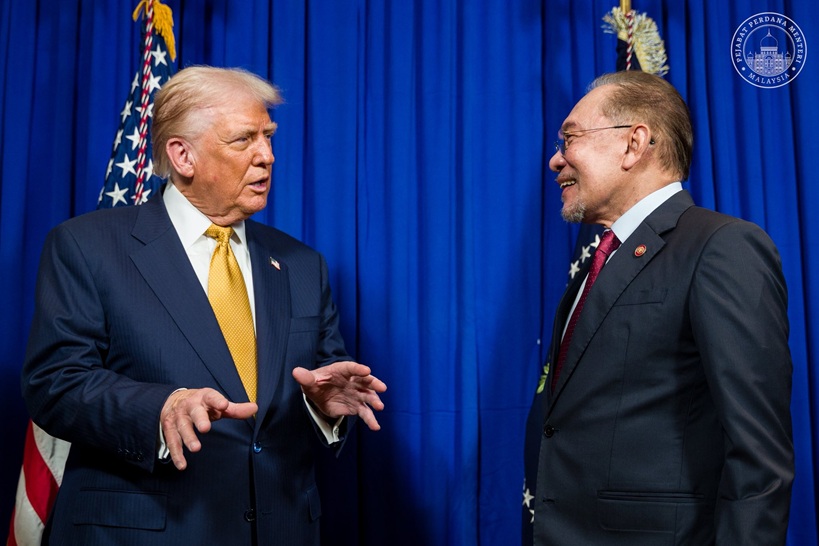Malaysia’s landmark trade deal with the U.S. sparks investor optimism, tariff-free access for key exports, and strategic commitments—signalling a new phase of bilateral integration and economic diplomacy

By Dr Mohd Safar Hasim
On 26 October 2025, Malaysia and the United States signed a landmark reciprocal trade agreement that marked a new chapter in bilateral economic relations.
The deal, which exempts 1,711 Malaysian export products from the standard 19% U.S. import tariff, was met with immediate approval from Bursa Malaysia. The Kuala Lumpur Stock Exchange (KLSE) responded with a sector-wide rally, signalling investor confidence in Malaysia’s strengthened trade position and the broader strategic implications of the agreement.
Malaysia’s trade relationship with the United States has long been characterised by a consistent surplus. Over the past six years, Malaysian exports to the U.S. have steadily outpaced imports, underscoring the country’s role as a reliable supplier of electrical and electronics (E&E), rubber products, palm oil, medical devices, and aerospace components.
While Malaysia’s trade surplus narrowed in 2024 due to a sharp increase in imports from the U.S., the overall balance remained positive. The tariff exemption deal is expected to reinvigorate Malaysia’s export momentum, particularly in sectors directly affected by the 19% tariff that has now been lifted.
The exempted products — valued at approximately US$5.2 billion cumulatively from 2019 to 2024 — span a wide range of strategic sectors. These include palm oil and derivatives, rubber products such as gloves and tires, cocoa and processed foods, pharmaceuticals, and aerospace components.
Prior to the agreement, these goods faced a uniform 19% U.S. import tariff. The removal of this barrier is expected to enhance Malaysia’s price competitiveness, expand market access, and stimulate production across export-oriented industries.
In return for these exemptions, the United States secured a series of strategic commitments from Malaysia. These include the procurement of 30 U.S.-made aircraft, with an option for 30 more, and purchases totalling US$150 billion in semiconductors, aerospace components, and datacentre equipment. Malaysia also agreed to import US$3.4 billion worth of liquefied natural gas (LNG) and
granted preferential access to U.S. exports in chemicals, machinery, metals, vehicles, dairy, poultry, rice, and ethanol.
On the regulatory front, Malaysia committed to digital trade reforms, including protections for cross-border data flows, the removal of discriminatory digital services taxes, and the lifting of broadcast airtime restrictions on U.S. content.
Cooperation on rare earths and critical minerals was also expanded, with extended operating licenses for U.S. firms.
The KLSE’s response was immediate and sector-specific. Rubber glove manufacturers such as TopGlove, Hartalega, and Supermax posted gains of 2–4%, anticipating stronger U.S. demand. Palm oil producers like Sime Darby Plantation and IOI Corporation rose by 1.5–3%, buoyed by the removal of tariffs on palm-based exports.
Aerospace engineering firms including UWC Berhad, SAM Engineering, and CTRM surged by 3–5%, reflecting optimism over Malaysia’s expanded role in the global aviation supply chain.
Pharmaceutical counters such as Pharmaniaga and Duopharma Biotech climbed by 2–3%, driven by expectations of increased U.S. market penetration.
The FBM KLCI index rose modestly by 0.6%, while the FBM Small Cap Index outperformed with a 1.2% gain, signalling broad investor enthusiasm.
Beyond immediate market reactions, analysts forecast a 15–20% increase in export volume for the exempted products over the next two years.
Sector-specific projections suggest that rubber products could grow by 22%, aerospace parts by 25%, palm oil by 18%, pharmaceuticals by 15%, and cocoa derivatives by 12%.
These gains are expected to restore Malaysia’s export momentum, especially after the slight dip in 2024, and reinforce its position as a competitive global supplier.
The strategic implications of the agreement extend beyond trade figures. For Malaysia, the deal represents a successful exercise in economic diplomacy — securing tangible benefits while preserving policy sovereignty. For the United States, it ensures reliable access to critical supply chains and opens new commercial avenues in Southeast Asia.
The reciprocal nature of the agreement also sets a precedent for future regional negotiations, potentially paving the way for an ASEAN–U.S. Free Trade Agreement. The agreement underscores the importance of public awareness and economic literacy.
Understanding trade dynamics empowers citizens to appreciate Malaysia’s global economic role and the strategic value of balanced, forward-looking trade policy. It also highlights the interconnectedness of domestic industries, international diplomacy, and investor sentiment — demonstrating how policy decisions can ripple through markets and communities.
In conclusion, the 2025 Malaysia–U.S. trade agreement is more than a tariff adjustment — it is a strategic realignment. Malaysia gains enhanced access to the world’s largest consumer market, while the U.S. secures supply chain partnerships and regulatory alignment.
Bursa Malaysia’s rally affirms the market’s belief in the deal’s long-term value. As Malaysia moves forward, this agreement positions the country not only as a regional export leader but also as a model for pragmatic, mutually beneficial trade diplomacy.
The views expressed here are entirely those of Dr Mohd Safar Hasim, a Council Member of the Malaysian Press Institute (MPI)